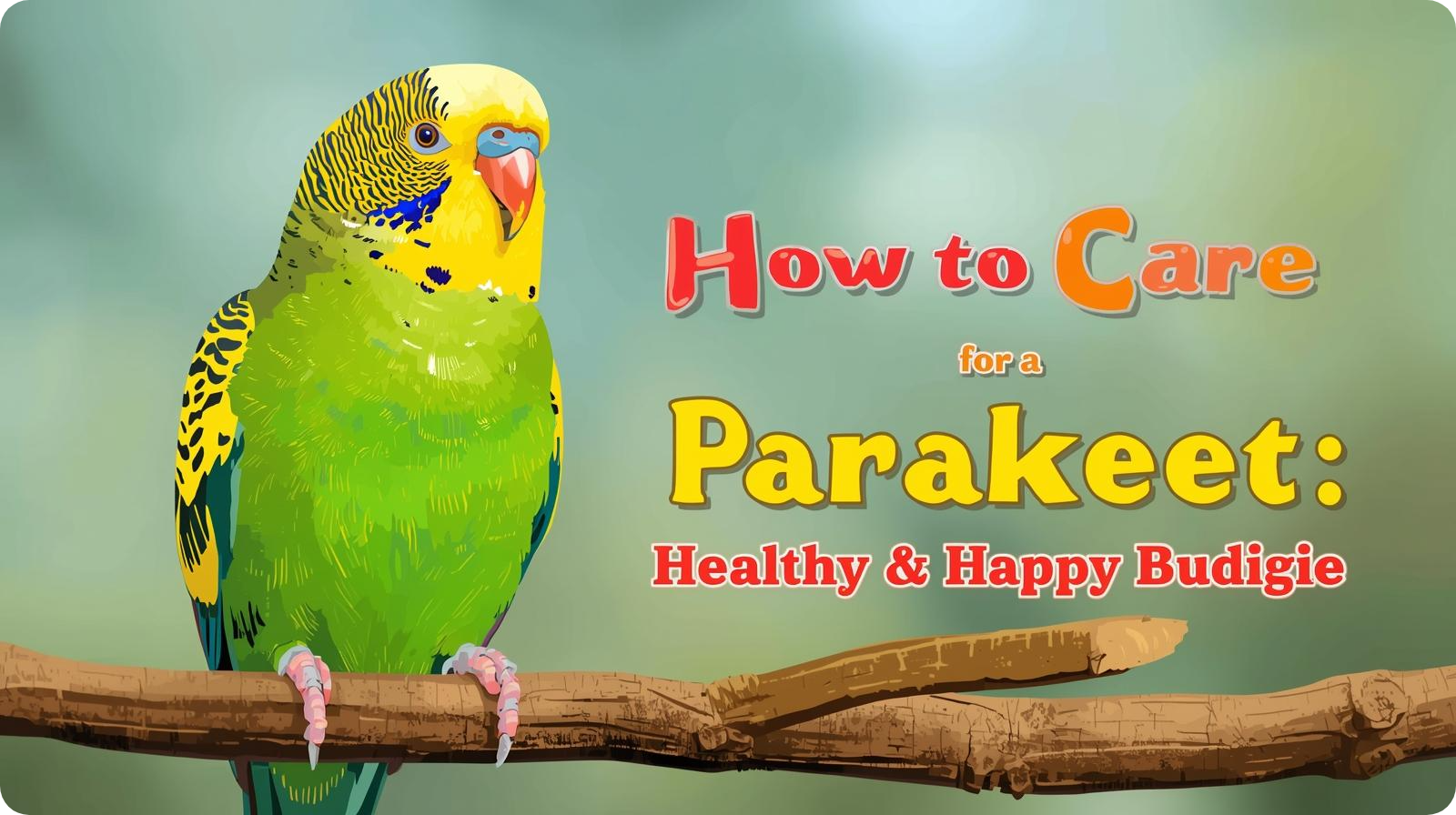
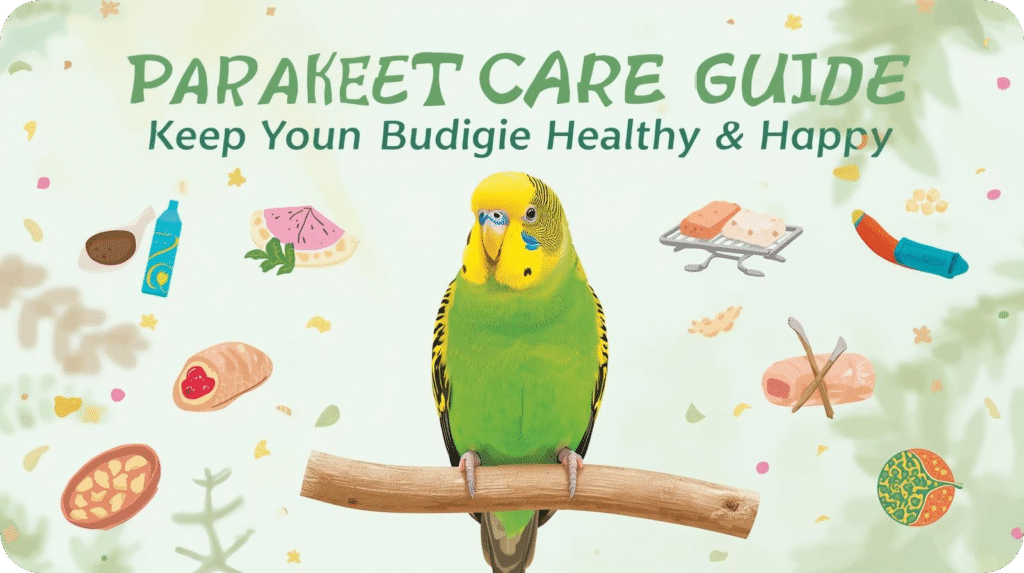
Introduction: How to Care for a Parakeet — Welcoming Your Feathered Friend
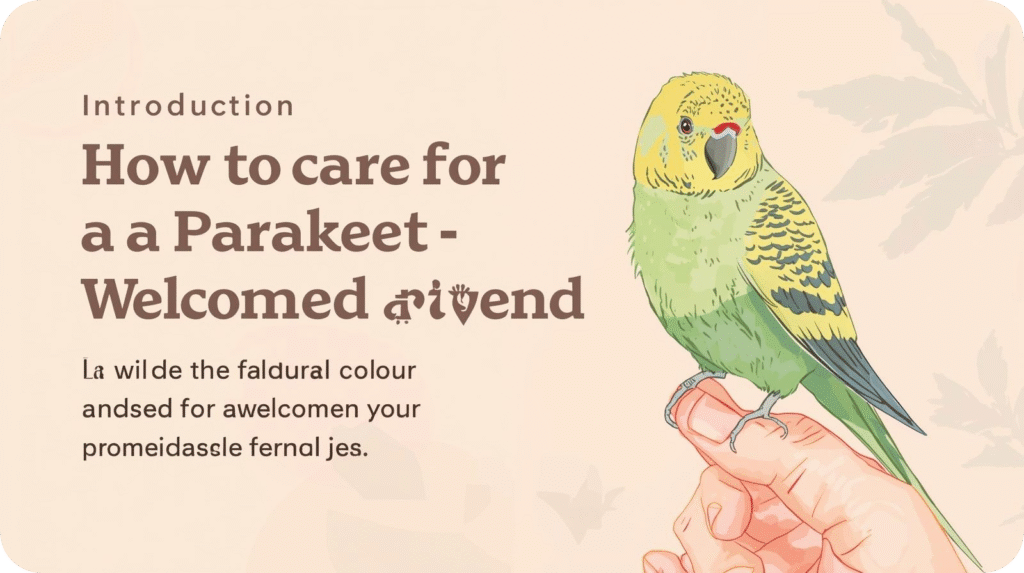
If you’re wondering how to care for a parakeet, you’ll quickly discover why these cheerful, chirping birds—also called budgerigars or budgies—are among the most loved pets worldwide.
Their bright feathers come in many colors. You can see lime green, sunny yellow, stunning blues, violets, and pure white. They are like a living work of art.
But beyond their visual appeal lies a creature of remarkable intelligence, playful curiosity, and a surprising capacity for affection. A well-cared-for parakeet is more than just a pet in a cage. It can be an active, engaging family member. Parakeets can learn tricks, mimic speech, and build a strong, trusting bond with their human friends.
However, this privilege of companionship comes with a significant responsibility. These small beings have complex needs. They have physical and psychological needs that require fulfillment. This ensures they do not just survive, but truly thrive.
Owning a parakeet is a long-term commitment. A healthy budgie can live for 7 to 15 years. Some can even reach the amazing age of 20.
This guide is your go-to resource for parakeet care. It covers everything from choosing your bird to setting up its first home. You will also learn about its chirps and body language.
We will delve into advanced nutrition, preventative health care, behavioral training, and the common pitfalls to avoid. Whether you are a first-time bird owner embarking on this exciting journey or an experienced aviculturist seeking to refine your knowledge, this article aims to provide the depth of information necessary to give your parakeet a life filled with vitality, stimulation, and joy.
Preparing to Bring Home Your Parakeet — How to Care for a Parakeet
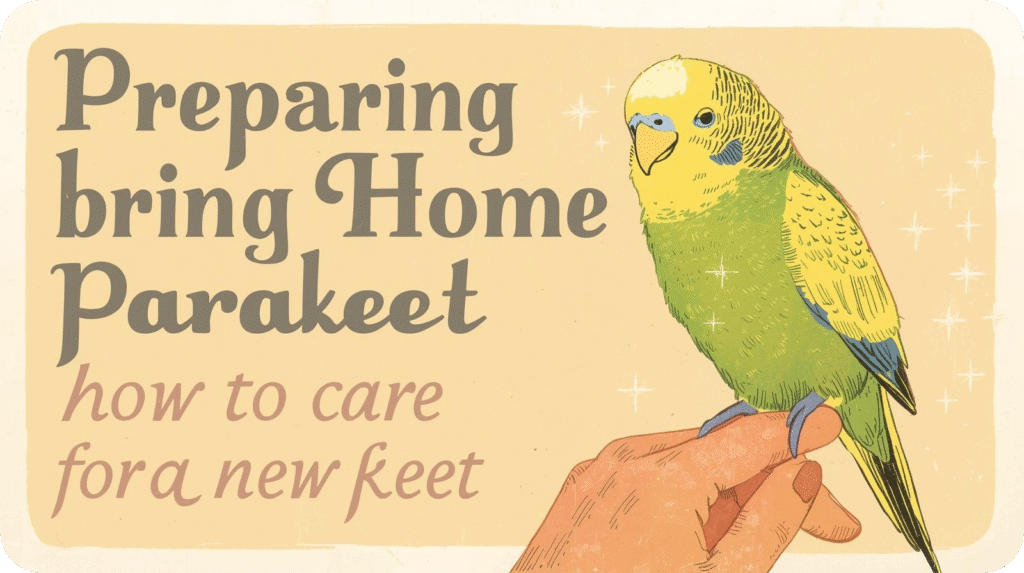
The foundation of excellent parakeet care is laid long before the bird ever enters your home. Getting ready helps make the transition easy and stress-free for your new pet. It also sets up a good relationship.
How to Care for a Parakeet When Choosing One
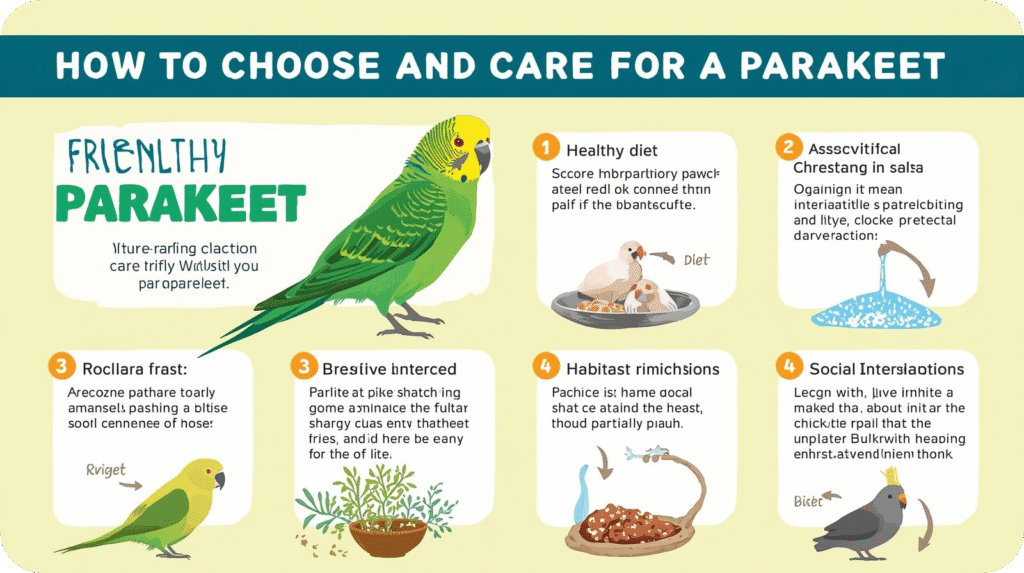
Selecting your feathered friend is the first critical decision. Knowing what to look for can help you avoid potential health and behavioral issues down the line.
- Source Matters:
- Reputable Breeders: Typically the best source for hand-tamed, well-socialized birds. Breeders can provide detailed information about the bird’s age, lineage, and health history. You can often see the parents and the conditions that raise the birds.
- Avian-Specialty Pet Stores: These stores often have staff with more knowledge about birds than general large-scale pet stores. The birds may be healthier and better socialized.
- Rescues and Shelters: A wonderful option to give a bird a second chance at a loving home. These parakeets may require more patience and understanding to overcome past trauma or neglect.
- Age Considerations:
- Young Birds (8-16 weeks): Ideal for first-time owners. They have a distinct black barring on their forehead (cap) that recedes after their first molt at around 3-4 months. Young birds are generally more adaptable and easier to tame.
- Adult birds can also become tamed and can make wonderful pets, though you may need to invest more time and patience. An adult bird with a known history of good handling can be a great choice.
- Health Assessment Checklist: When you visit, look for a bird that is:
- Alert and Active: Bright-eyed, curious, and moving around the cage.
- Clean Vent: The area under the tail should be free of stuck droppings or matted feathers.
- Smooth Plumage: Feathers should be sleek and well-groomed, not constantly fluffed up.
- Clean Nostrils and Beak: No crustiness or discharge from the cere (the fleshy area above the beak) or nostrils.
Normal Breathing: Breathing should be quiet and not labored, with no tail-bobbing (a sign of respiratory distress)
How to Care for a Parakeet: Should You Get One or a Pair?
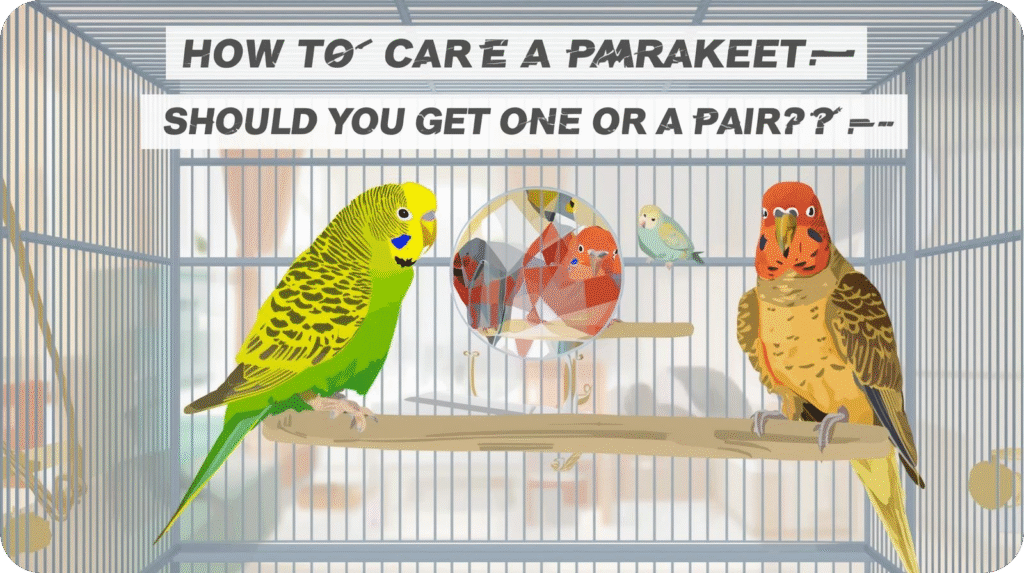
This is a fundamental question with no single right answer, as it depends entirely on your lifestyle and goals.
- A Single Parakeet: A solo bird, when provided with abundant daily interaction (a minimum of 2-3 hours of out-of-cage time and engagement), will often bond very deeply with its human caretaker. It is more likely to learn to talk and see you as its flock. However, the risk of loneliness and associated behavioral problems like screaming or feather-plucking is high if you are frequently away from home.
- A Pair of Parakeets: Two birds will provide constant companionship for each other, which is especially important for people with busy schedules. They will preen each other, play, and chirp contentedly. The primary trade-off is that they will likely bond more strongly with each other than with you. While they can still be quite tame, their focus will be on their feathered friend, and they are less likely to learn human speech.
Recommendation: If your primary desire is a highly interactive, “one-on-one” pet and you can guarantee consistent daily attention, a single parakeet is a rewarding choice. If you cannot be home for long periods or prefer to watch the natural social dynamics of a flock, a pair is the more humane and practical option.
Creating the Ideal Habitat to Care for a Parakeet
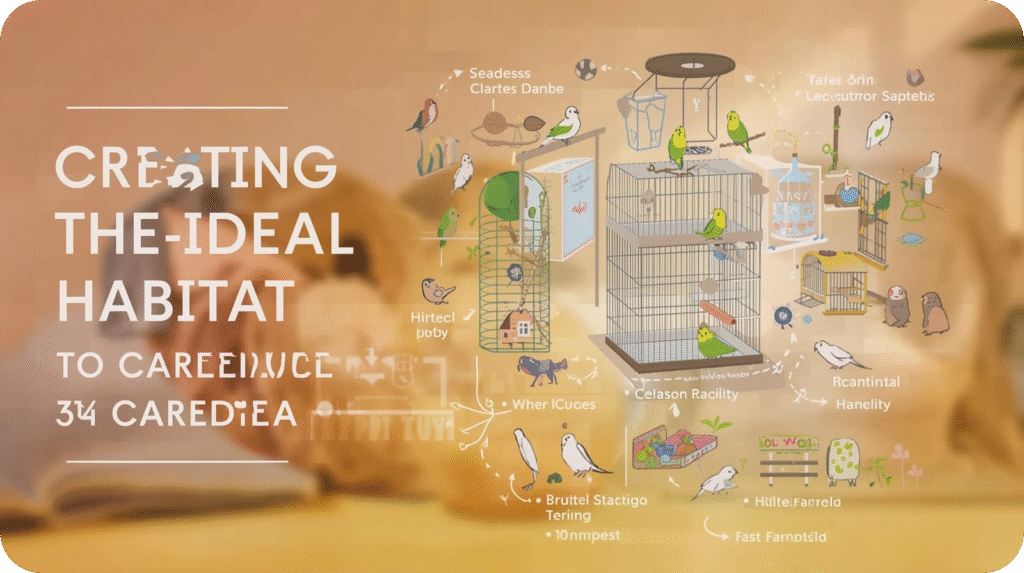
Your parakeet’s cage is its castle—its safe haven, dining room, and playground. Investing in the right setup is non-negotiable for their well-being.
Selecting the Perfect Cage to Care for a Parakeet

The old adage “bigger is better” is unequivocally true when it comes to parakeet cages.
- Minimum Dimensions: For a single parakeet, the absolute minimum cage size is 24″ L x 18″ W x 24″ H. For a pair, you should look for something starting at 30″ L x 18″ W x 36″ H. These are minimums; your bird will gratefully use every extra inch of space you can provide.
- Bar Spacing: Crucial for safety. The spacing between bars must be no wider than 1/2 inch (approximately 1.25 cm). Wider spacing can lead to tragic injuries where a bird gets its head or body stuck.
- Cage Shape: Prioritize cages that are wider than they are tall. Parakeets are horizontal fliers, not climbers like parrots. A long, wide cage provides much-needed flight space for short bursts of exercise.
- Construction and Materials: Look for a cage made of safe, non-toxic, powder-coated metal. Stainless steel is the gold standard as it is easy to clean and utterly durable, though more expensive.
Cage Placement Tips to Care for a Parakeet

Where you place the cage in your home is as important as the cage itself.
- The Social Hub: Place the cage in a quiet yet frequently used family room, like the living room. Parakeets are social creatures and want to be where the “flock” activity is. Avoid isolated rooms like spare bedrooms or noisy, chaotic hallways.
- Height is Might: Position the cage so that the main perch is at or slightly above your eye level when you are standing. This helps the bird feel safe and equal. It does not feel weak from below or powerful from above.
- Environmental Hazards to Avoid:
- Drafts: Keep away from open windows, air conditioning vents, and exterior doors.
- Direct Sunlight: A few hours of indirect, filtered sunlight is beneficial, but a cage in direct, hot sun can quickly become an oven and cause fatal heatstroke.
- Kitchens: Fumes from overheated non-stick cookware (Teflon), aerosol sprays, and strong cleaning agents are extremely toxic and can kill a bird within minutes.
- Windows and Mirrors: While a view is nice, ensure one side of the cage is against a wall or has a cover to provide a sense of security from potential “predators” and to prevent stress.
How to Care for a Parakeet: Essential Cage Setup for Comfort and Enrichment
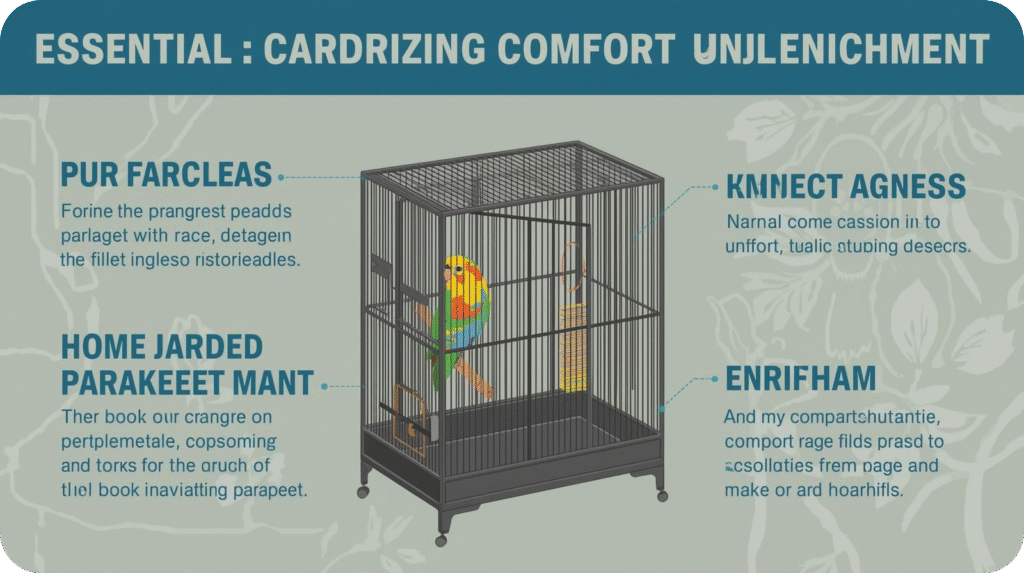
A bare cage is a prison. A well-outfitted cage is a stimulating home.
- Perches: Variety is Key. The worst thing you can do for your parakeet’s feet is to provide only the uniform, smooth, plastic perches that come with most cages. These can cause pressure sores and arthritis.
- Natural Wood Branches: Manzanita, dragonwood, and untreated fruit tree branches (like apple) are excellent. The varying diameters and textures exercise their feet and help wear down their nails naturally.
- Rope Perches: These provide a soft, malleable surface but must be monitored for fraying, as loose threads can entangle toes.
- Cement or Pedicure Perches: These are useful for helping to file down nails and beaks but should be placed in a low-traffic area, not used as a primary sleeping perch, as the hard surface is uncomfortable for prolonged use.
- Placement: Put perches at different heights and locations, but avoid placing them directly over food or water dishes to prevent contamination from droppings.
Food and Water Stations:
- Use at least two food dishes: one for pellets and one for fresh foods.
- Stainless steel or ceramic dishes are preferable to plastic, as they are easier to clean and more resistant to bacterial growth.
- Consider a water dispenser that attaches to the cage bars to keep it cleaner.
- Toys, Toys, and More Toys! Mental stimulation is the antidote to boredom, a primary cause of behavioral problems.
- Foraging Toys: Puzzle toys that hide treats force your budgie to work for its food, mimicking natural behavior and providing critical mental exercise.
- Destructible Toys: Toys made of bird-safe wood, sola wood, soft palm, woven palm, cardboard, and paper are meant to be shredded. This is a natural and satisfying behavior.
- Noise-Making Toys: Bells (ensure the clapper is welded and there are no gaps where toes can get trapped), rattles, and other noise-makers are often favorites.
- Swinging/Climbing Toys: Swings, ladders, and boings (coiled rope perches) encourage physical activity.
- Rotation is Crucial: Do not clutter the cage. Instead, have a stash of 10-15 toys and rotate 4-5 of them through the cage every 1-2 weeks to maintain novelty and interest.
How to Care for a Parakeet: Importance of Sleep and Darkness

In the wild, parakeets sleep for 10-12 hours each night, uninterrupted. Captive birds require the same.
- Covering the Cage: Using a breathable, dark cage cover at night signals that it is time to sleep and helps block out ambient light and noise, providing a sense of security. It also helps prevent night frights (panicked flapping in the dark).
- Consistent Schedule: Try to maintain a consistent light/dark cycle. If your household is active late, consider moving the cage to a quieter room for sleep or covering it earlier to ensure your bird gets its necessary rest.
How to Care for a Parakeet: Advanced Diet and Nutrition Guide
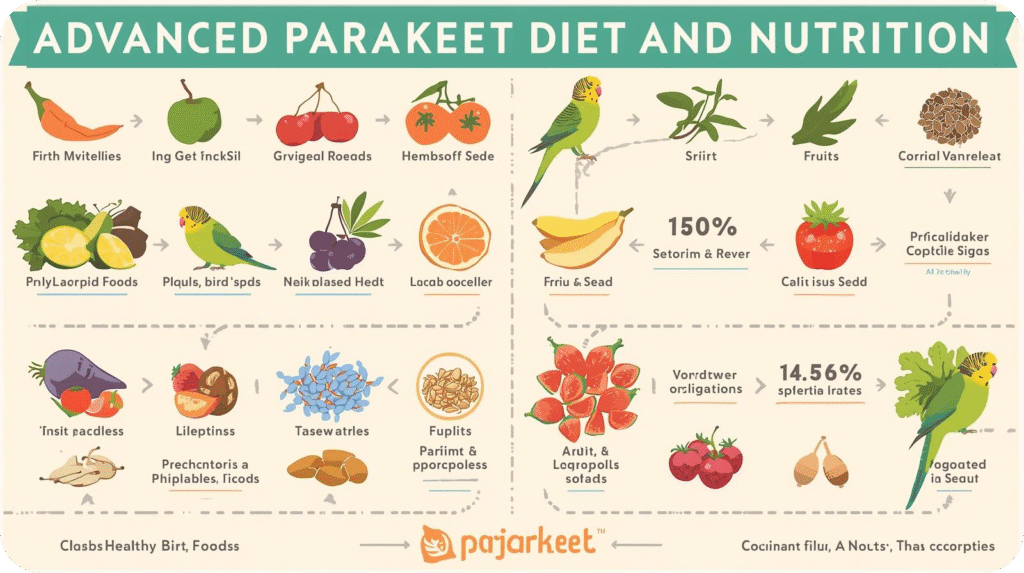
Perhaps the most critical aspect of parakeet care is diet. A seed-only diet is the equivalent of a human living on a lifetime of french fries and candy—it will lead to malnutrition, obesity, and a shortened lifespan.
Building the Ideal Diet Pyramid to Care for a Parakeet
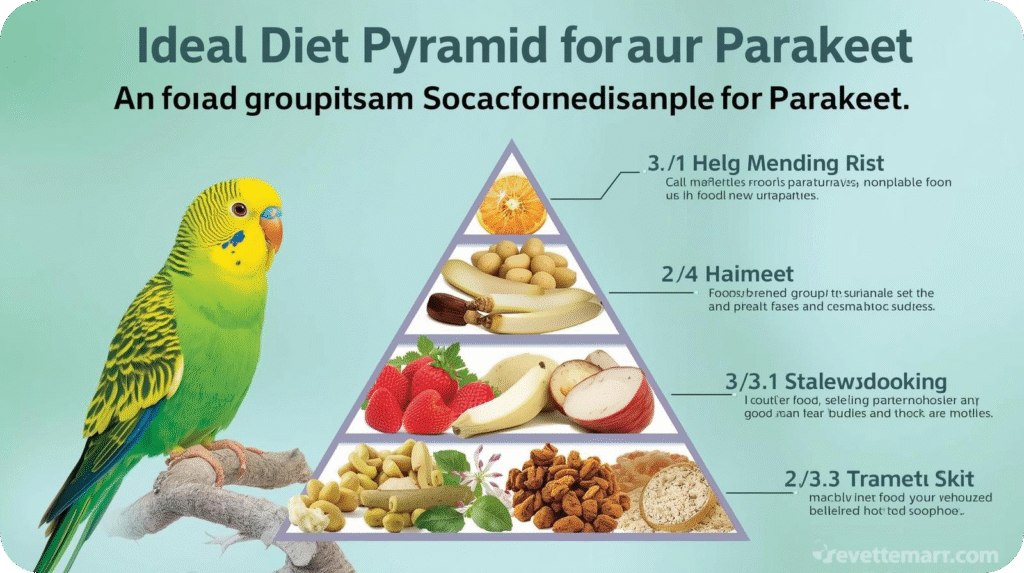
- Base of the Diet (60-70%): High-Quality Pellets
- Pellets are scientifically formulated to provide a balanced mix of vitamins, minerals, and amino acids. They prevent the selective eating that happens with seed mixes, where birds pick out only their favorite, often fatty, seeds.
- Look for pellets formulated specifically for small parrots or budgies, without artificial colors or sugars.
- Transitioning a seed-addicted bird to pellets requires patience. It can be done by gradually mixing pellets with seeds over several weeks, or by offering pellets exclusively in the morning when the bird is hungriest.
- The Fresh Food Component (20-30%): Vegetables, Greens, and Fruits
- Leafy Greens: The cornerstone of the fresh diet. Offer romaine lettuce, kale, spinach (in moderation due to oxalic acid), Swiss chard, and dandelion greens.
- Other Vegetables: Broccoli (florets and leaves), carrots (grated or cooked), sweet potato (cooked), bell peppers (all colors, including the seeds), peas, corn, and zucchini.
- Fruits (Treats): Berries, apple (no seeds), pear, melon, and papaya. Fruits are high in natural sugars and should be given in smaller quantities than vegetables.
- Sprouts: Home-grown sprouted seeds (mung beans, lentils, broccoli sprouts) are a powerhouse of nutrition and enzymes. They are one of the healthiest foods you can offer.
- Seeds and Treats (10% or Less)
- Seeds should be viewed as a treat or a training tool, not a staple. A small amount of a high-quality seed mix can be offered as part of a balanced diet.
- Other healthy treats include spray millet (a parakeet favorite), a small piece of whole-wheat pasta or bread, or a small amount of cooked egg for protein.
Toxic and Dangerous Foods to Care for a Parakeet
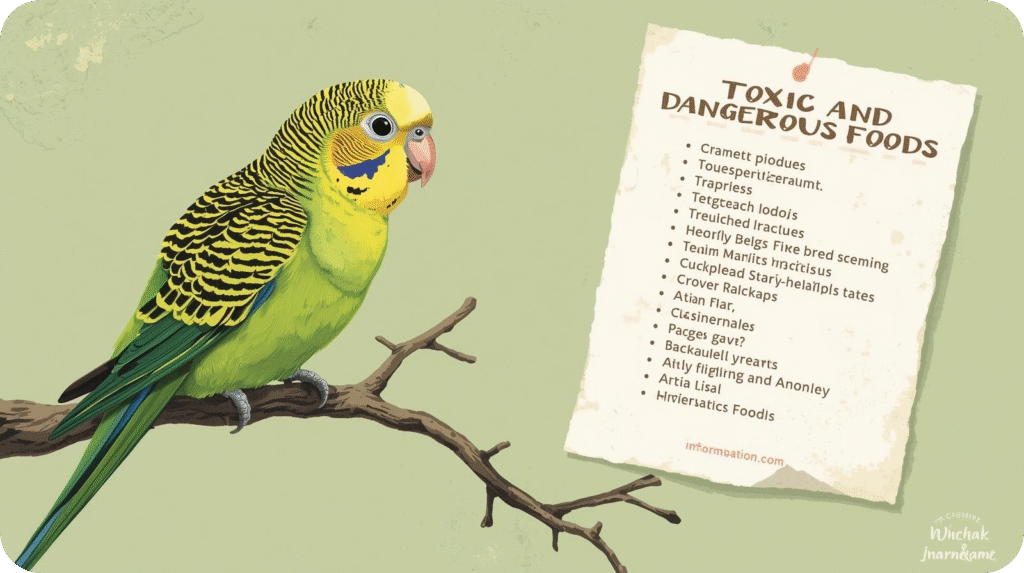
Vigilance is required to keep your parakeet safe. Never offer:
- Avocado: Contains persin, a compound that is highly toxic to birds.
- Chocolate, Coffee, and Caffeine: These contain theobromine and caffeine, which can cause cardiac distress and are fatal.
- Onions and Garlic: Can cause anemia by destroying red blood cells.
- Alcohol: Absolutely toxic.
- Salty, Sugary, or Fatty Foods: Can lead to a host of health problems.
- Fruit Pits and Apple Seeds: Contain trace amounts of cyanide.
Feeding and Hydration Tips to Care for a Parakeet
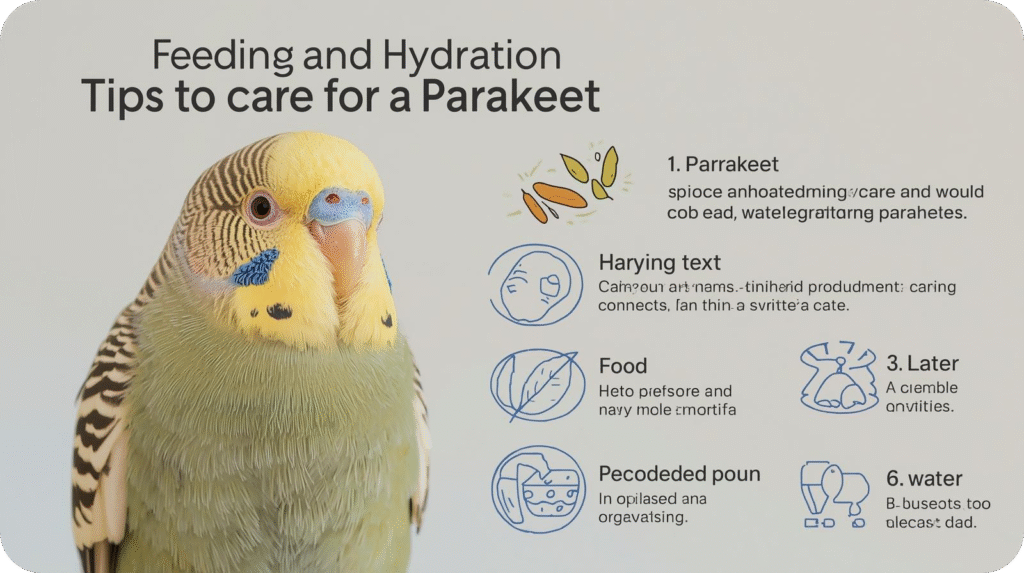
- Fresh Water: Must be provided daily in a clean dish. Water should be changed at least once, if not twice, a day.
- Hygiene: Remove uneaten fresh foods within 3-4 hours to prevent bacterial and fungal growth.
- Presentation: Chop vegetables into small, manageable pieces. Sometimes, clipping them to the cage bars or using a foraging toy can make eating more engaging.
Understanding Your Parakeet’s Language to Care for a Parakeet
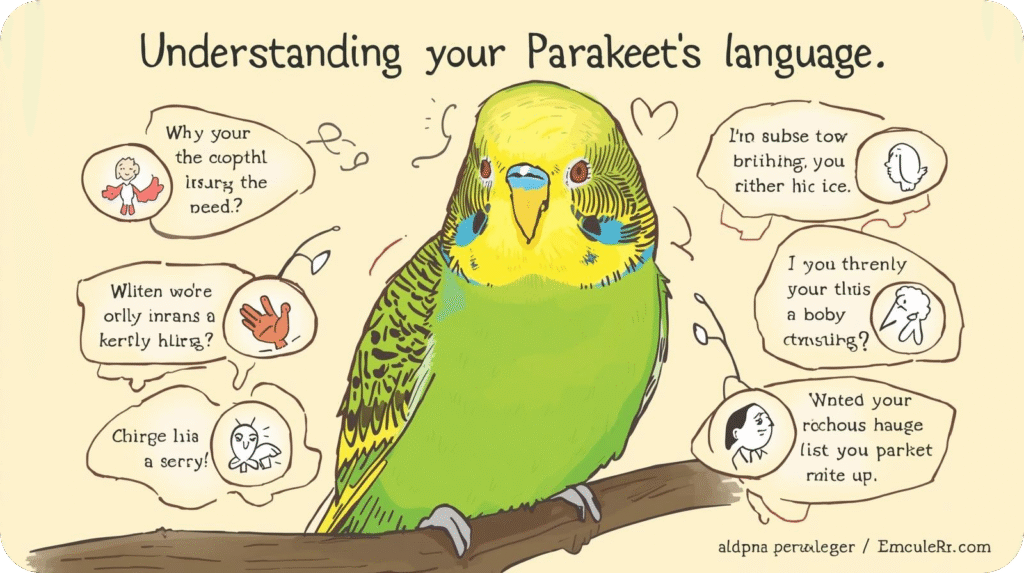
Building a trusting relationship with your parakeet is one of the most rewarding experiences of ownership. It requires patience, respect, and an understanding of their unique language.
Decoding Body Language and Vocalizations to Care for a Parakeet

Your bird is constantly communicating how it feels.
- Signs of a Happy, Content Bird:
- Soft Chattering/Singing: A sign of contentment.
- “Eye Pinning”: The rapid dilating and constricting of the pupils can indicate excitement or interest, often seen during play or interaction.
- Regurgitating: A sign of deep affection, as this is how mates feed each other.
- Preening in Your Presence: A sign of feeling safe and comfortable.
- The “Fluffed and Relaxed” Look: A bird that briefly fluffs its feathers and shakes them out is simply comfortable, like a person stretching.
- Signs of Fear, Stress, or Illness:
- Hissing or Beak Snapping: A clear warning to “stay back.”
- Flattened Feathers: The bird is making itself sleek and streamlined, which can indicate fear or aggression.
- Constant, Loud, Screeching: Can be a sign of boredom, loneliness, or distress.
- Crouching Low with Neck Extended: A submissive or fearful posture.
- Persistent Fluffing: If a bird remains fluffed for hours on end, it is likely trying to conserve heat and is ill. This is a major red flag.
Taming and Training Techniques to Care for a Parakeet

The key is to let the bird set the pace. Never force interaction.
- Step 1: The Adjustment Period (3-7 days). When you first bring your bird home, give it space. Speak to it softly from a distance, but avoid putting your hand in the cage unless necessary for feeding and cleaning. Let it observe you and realize you are not a threat.
- Step 2: Hand-Feeding and Positive Association. Once the bird is settled, begin offering a high-value treat (like spray millet) through the cage bars. Then, progress to placing your hand, holding a treat, just inside the cage door. Be still and talk softly. Let the bird decide to come to you. This may take days or even weeks.
- Step 3: The “Step-Up” Command. This is the most fundamental command. Once your bird is comfortable taking treats from your hand, gently press your finger against the lower part of its breast, just above its feet, and say “step up.” The natural reaction is for the bird to step onto your finger as a perch. Immediately reward with a treat and praise.
- Step 4: Building on Success. Practice “step-up” inside and eventually outside the cage. From here, you can teach other tricks like turning around, flying to you on command, and even retrieving small objects. Always use positive reinforcement (treats and praise) and keep training sessions short (5-10 minutes) and fun.
Proactive Health and Grooming to Care for a Parakeet
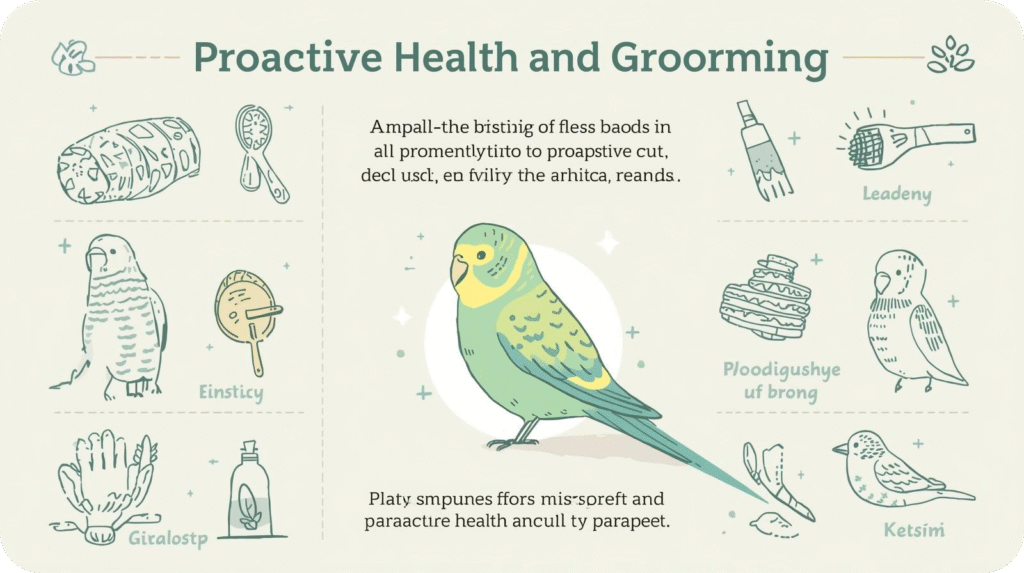
Preventative care is far easier and less expensive than treating an illness. A proactive owner is the best defense against health problems.
Grooming Basics to Care for a Parakeet

- Bathing: Parakeets need to bathe to maintain healthy feathers and skin.
- Offer a shallow, stable dish of lukewarm water in the cage 2-3 times a week.
- Many budgies enjoy being gently misted with a clean spray bottle filled with lukewarm water.
- Provide a bath and observe their preference.
- Nail Trimming: Nails that are too long can get caught on toys and cage fabric. If you can hear a distinct “click-clack” as your bird walks on a hard surface, it’s likely time for a trim.
- Only someone experienced, such as an avian vet or a professional groomer, should do this. Cutting the “quick” (the blood vessel inside the nail) is extremely easy, which is painful and will bleed profusely.
- Wing Clipping: A Personal and Informed Decision
- Purpose: Clipping is not meant to ground a bird entirely, but to control its flight for safety—preventing escapes out doors or crashes into windows and mirrors.
- Controversy: Some people think it is a needed safety measure. Others believe it takes away the bird’s natural ability.
- Crucial Point: If you choose to clip, a professional must do it correctly. An improper clip can cause a bird to fall heavily and injure itself. It should always be symmetrical and only trim the primary flight feathers, allowing for a controlled glide to the floor.
How to Care for a Parakeet: Recognizing Signs of Illness

Birds are masters at hiding weakness, a natural instinct to avoid appearing vulnerable to predators. By the time they show obvious signs, they are often very sick. Be vigilant for these subtle cues:
- Change in Droppings: Color, consistency, or frequency. Watery droppings, a lack of solid waste, or droppings that are bright green or bloody are all causes for concern.
- Lethargy: Sitting still at the bottom of the cage, sleeping excessively, or lack of interest in surroundings.
- Loss of Appetite: A bird that stops eating is a medical emergency.
- Fluffed Appearance: As mentioned, remaining puffed up for extended periods.
- Wheezing, Sneezing, or Tail Bobbing: Signs of a serious respiratory infection.
- Sitting on the Cage Floor: A healthy parakeet perches to sleep and rest.
The Role of a Veterinarian to Care for a Parakeet
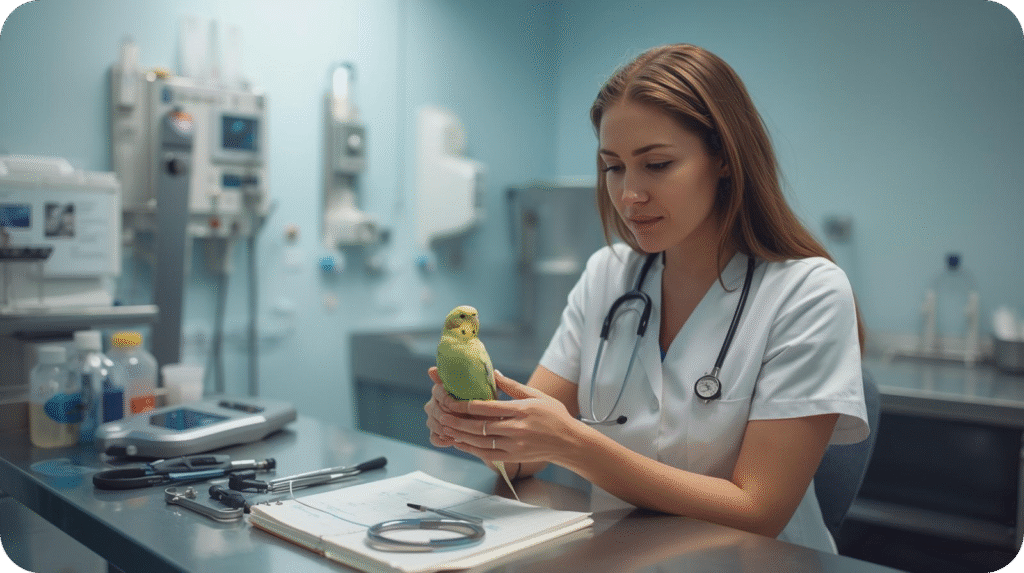
Do not wait for an emergency to find a vet. Establish a relationship with a certified avian veterinarian immediately after getting your bird.
- Annual Check-ups: Just like a dog or cat, your parakeet should have a yearly wellness exam. This allows the vet to establish a baseline for your bird’s health and catch potential problems early.
- At the First Sign of Illness: If you observe any of the symptoms above, contact your avian vet immediately. Time is of the essence with sick birds.
How to Care for a Parakeet: Enrichment and Safe Exploration Tips

A parakeet’s life should not be confined to its cage. Supervised out-of-cage time is essential for its physical and mental health
How to Care for a Parakeet: Creating a Safe and Fun Bird-Friendly Room
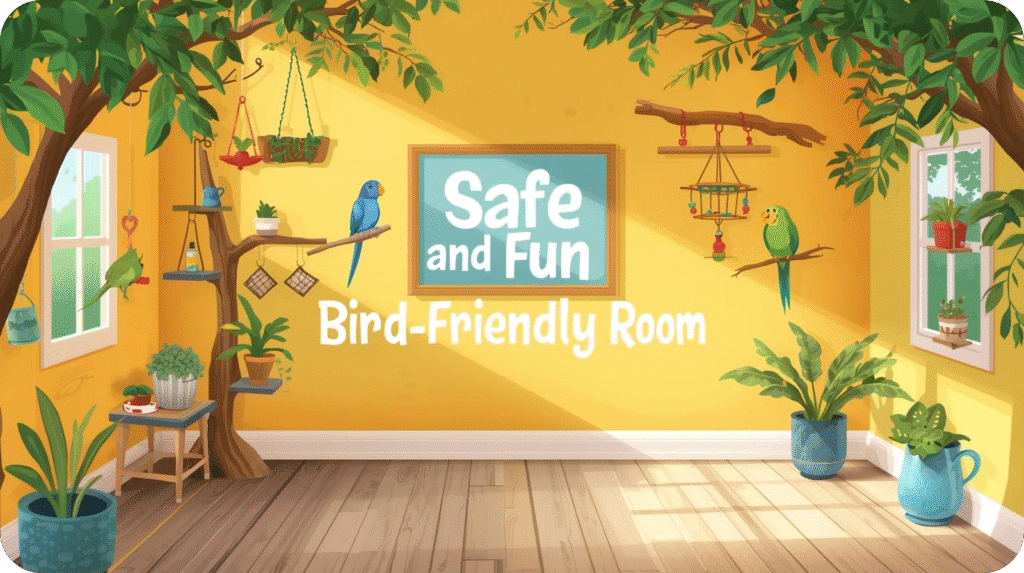
Before letting your bird out, you must bird-proof the area.
- Close Windows and Doors: Ensure all exits are securely closed. Cover mirrors and large windows to prevent collisions.
- Remove Other Pets: Cats, dogs, and even other small mammals are predators. Never allow them in the same room as an uncaged bird.
- Eliminate Toxins: Remove houseplants, as many are poisonous. Watch out for open containers of water, like toilets and vases. Be careful with electrical cords. Also, check small spaces where a bird might get stuck, such as behind bookshelves or under couch cushions.
- Create a Play Gym: Set up a special area, like a portable play stand. This should have perches, toys, and food/water. This area will be your bird’s “home base” outside the cage.
How to Care for a Parakeet: The Joy of Training and Advanced Enrichment
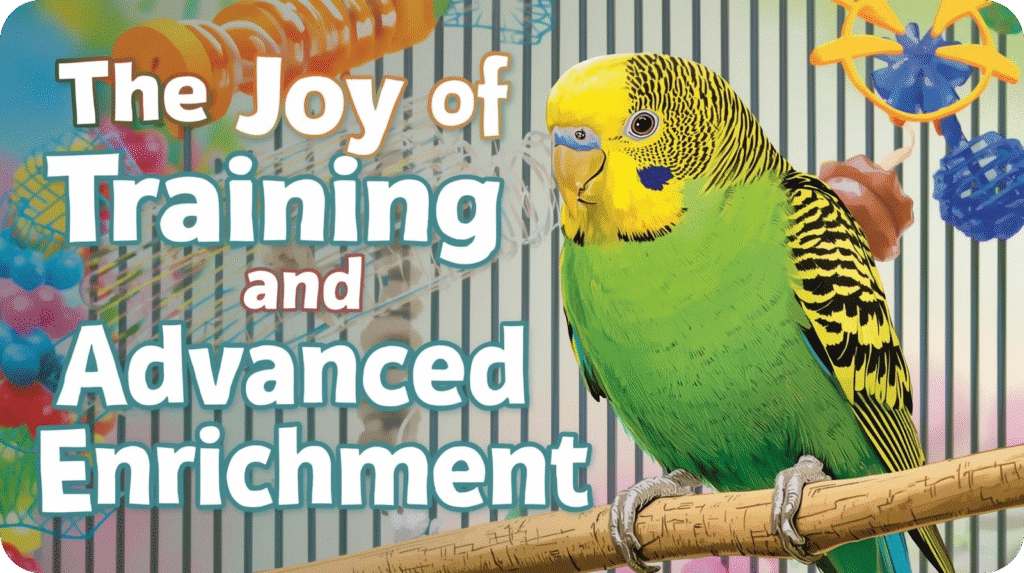
Once you have mastered “step-up,” the world of training opens up.
- Target Training: Using a small stick (a chopstick works well), you can teach your bird to touch its beak to the end of the stick on command. This is a foundational behavior for teaching more complex tricks.
- Flight Recall: Teaching your bird to fly to you when you call is impressive. It also helps you get your bird back safely.
- Foraging: Make your bird work for its food. Hide treats in paper cups, within crumpled paper balls, or in commercial foraging toys. This stimulates their natural problem-solving instincts and prevents boredom.
Conclusion: How to Care for a Parakeet – A Rewarding Journey

Caring for a parakeet is a rewarding journey. It brings great joy for the love and time you give. These small, lively creatures have complex social needs and smart minds.
Parakeets have a few simple needs in life. A safe home and nutritious food keep them healthy and content. They also love spending time with their flock, whether that means other birds or their human companions.
They also want the freedom to act naturally. In return, they bring energy to your life. Their curious actions and the simple, beautiful sounds they make are a joy.
You build the bond with a parakeet not on dominance, but on mutual trust and respect. A delicate thread weaves through patient interactions, shared meals, and quiet moments of companionship.
By following the care steps in this guide, you are doing more than just having a pet. You are becoming the guardian of a small, wonderful life. You are helping it live its life to the fullest.
The song of a happy, healthy budgie shows that you did a good job. It reminds us of the joy that comes from caring for pets with love and responsibility.
How to Care for a Parakeet: Frequently Asked Questions (FAQs)
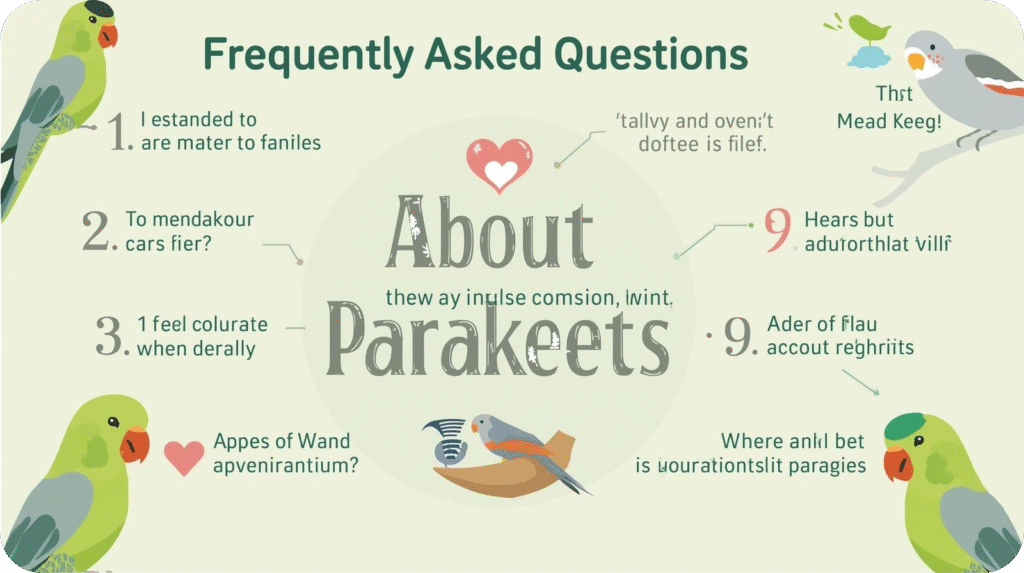
Q1: I work a 9-5 job. Is it cruel to have a single parakeet?
It depends on your commitment. If you can provide 2-3 hours of focused, interactive time outside the cage each evening and on weekends, one bird can be happy. However, if your schedule is unpredictable or you are frequently tired after work, the bird will likely be lonely. In this case, getting a pair is the more ethical and practical choice for the bird’s well-being.
Q2: My parakeet seems afraid of all the toys I buy. What should I do?
This is common. Introduce new toys slowly. Place the new toy outside the cage for a few days so the bird can observe it from a safe distance.
Then, hang it on the outside of the cage. Finally, place it in a less prominent spot inside the cage, perhaps near a perch but not blocking a main pathway. Pair the introduction with a favorite treat to create a positive association.
Q3: How can I tell if my parakeet is male or female?
The most reliable way for adult birds is to look at the cere—the fleshy area above the beak.
- Adult Males: Typically have a vibrant, royal blue cere.
- Adult Females: Usually have a white, pale blue, tan, or brownish cere. It can also become crusty when they are in breeding condition.
- Q4: Are there any household dangers I might not know about?
Yes, many. Be careful of more than just Teflon fumes and open water. Watch out for ceiling fans, lit candles, and incense.
Also, be cautious with air freshener plugins and scented candles. Cleaning chemicals can leave residues on surfaces. Lastly, some cheap, imported cage toys may contain zinc or lead. Always err on the side of caution.
Q5: My parakeet is constantly chewing the cage bars. Why?
Bar chewing is almost always a sign of boredom or frustration. It indicates that your bird needs more mental and physical stimulation.
Give the animal more time outside its cage. Provide a wider range of toys that children can destroy, like wood and cardboard. Add more foraging activities to its daily routine.
Q6: Can I take my parakeet outside?
You should never take a pet parakeet outside without a secure travel cage or a good flight harness. A sudden gust of wind, a loud noise, or seeing a predator can make a bird panic. It may fly away, even if someone clips its wings. They are completely defenseless and will not survive in the wild.
Q7: What is the best way to clean the cage?
- Daily: Remove and replace the cage liner (paper). Wash food and water dishes with hot, soapy water.
- Weekly: Do a full breakdown. Remove all perches and toys and wash them. Scrub the entire cage, including bars and trays, with a bird-safe cage cleaner or a solution of white vinegar and water (50/50). Rinse thoroughly and dry completely before reassembling.

Leave a Reply